SOPs for Vehicle Location Tracking System Device Fitment
Government of West Bengal
Transport Directorate
Paribahan Bhawan – II (1st Floor)
CSTC Depot, Kasba, Kolkata – 700 108
Memo No. 466/T-Dte/2022 dated 08.12.2022
Notice related to Standard Operating Procedure (SOP) For VLTD (AIS-140)
Fitment & Tagging
Transport Department, Government of West Bengal has implemented Vehicle Location Tracking System (AIS-140) in the State w.e.f 01/12/2022 as per Notification and guideline of MoRTH.
For smooth implementation of the VLT system all enlisted VLT device manufacturers/ Vehicle OEM dealers/ Authorized dealers/ RFCs are hereby requested to follow Standard Operating Procedure (SOP) enclosed herewith for VLT Device (AIS-140) Fitment & Tagging in the State of West Bengal.
Director,
Transport Directorate, W.B.
Standard Operating Procedure (SOP) For VLTD Fitment & Tagging
1. About the system
Government of India has mandated Vehicle tracking system and panic button in all public transport vehicles. AIS140 is the standard recommended by Ministry of Road Transport & Highway (MoRTH) for vehicle tracking device in India. West Bengal Department of Transport (WBDT) has decided to implement AIS140 based Vehicle tracking system in all public transport vehicles. WBDT has entrusted C-DAC, a government of India agency under Ministry of Electronics and Information Technology (MeitY) for the implementation of the project. C-DAC has developed the Software application to monitor all vehicles fitted with tracking device.
WBDT has short listed various manufacturers & models of AIS140 certified Vehicle Location Tracking (VLT) devices. Vehicle owner can choose from any of the approved VLTD manufacturers and models. It is the sole responsibility of vehicle owner to deal with the matter related to quality, price, and warranty & service agreement with the VLTD manufacturer/ dealer.
Pre-Requisites of VLT Device Registration and Activation
- The VLT device manufacturer/ OEM dealer/ Authorized dealer should get their devices tested from any of the testing agencies referred to in rule 126 of the Central Motor Vehicles Rules, 1989.
- VLT devices shall be tested for conformity of production every year after the first certification, from the testing agencies referred to in rule 126 of the Central Motor Vehicles Rules, 1989
- The testing agencies shall upload the details of the VLT devices certified by them on the VAHAN database. Testing agencies shall also update the status relating to the Conformity of Production (CoP) on the VAHAN / State Registration Application
- The device should be certified for AIS140 compliance by any of the testing agency mentioned in rule 126 of CMVR. This Type Approval Certificate (TAC) of the certified VLTD model needed to be uploaded to NIC’s VAHAN/VLTD Maker portal.
- Once TAC is uploaded in VAHAN, login credentials for VAHAN will be provided for the VLTD manufactures.
- VLTD Manufacturers can login to VAHAN and upload VLTD inventory details.
- VLTD Manufacturers should arrange registered agencies/dealers for fitment and servicing of VLTD fitted in vehicles.
- VLTD Manufacturers should have a supervisory control over dealer’s operations and should ensure quality service to customers.
- WBDT & C-DAC shall communicate with device Manufacturers only.
- State backend application login credentials for manufacturers will be provided by the WBDT admin.
- Using the credentials, VLTD Manufacturers can login to the State backend application and can add dealers as per approval given by WBDT.
2. Steps Involved in VLTD Fitment & Tagging
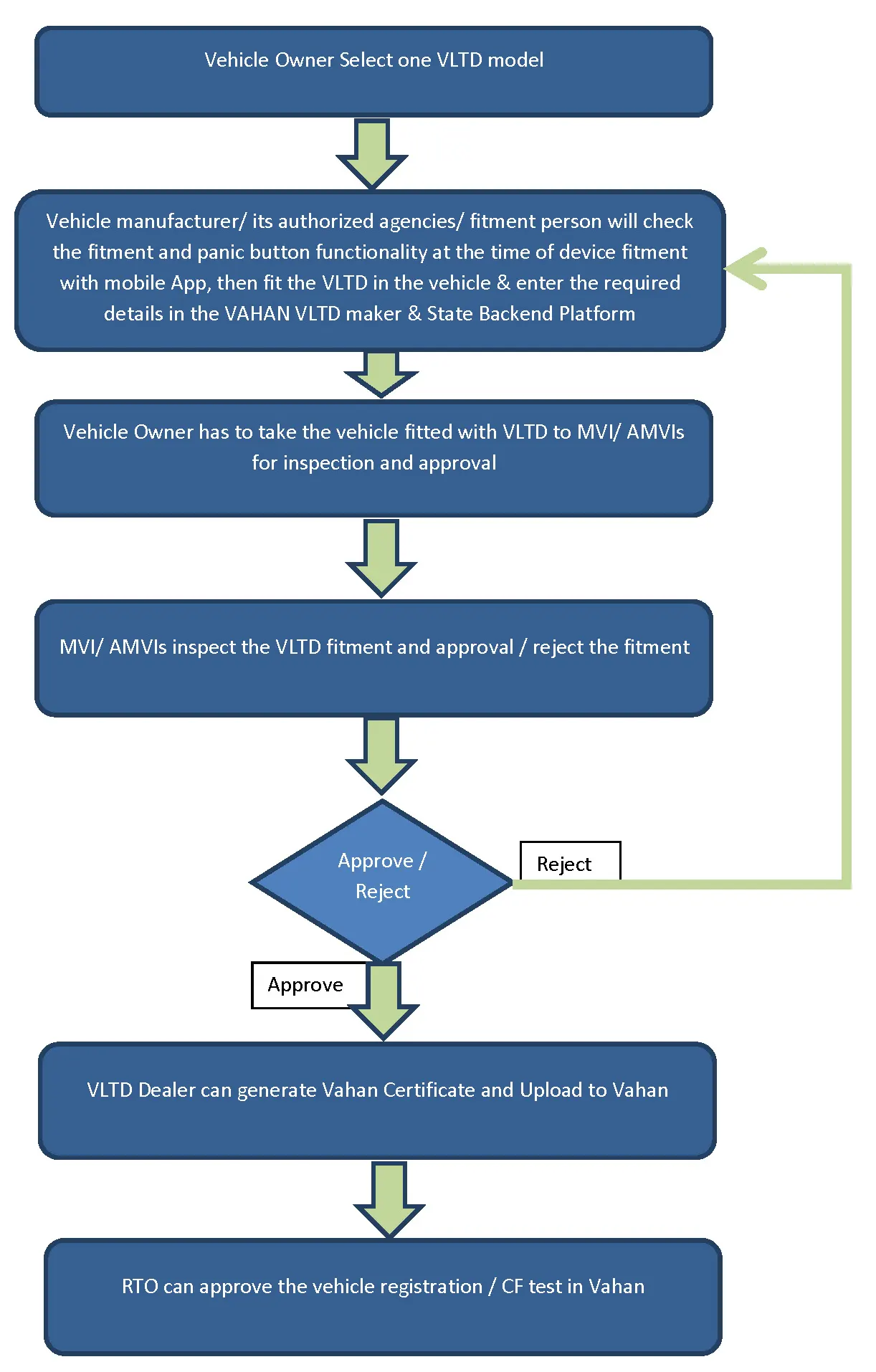
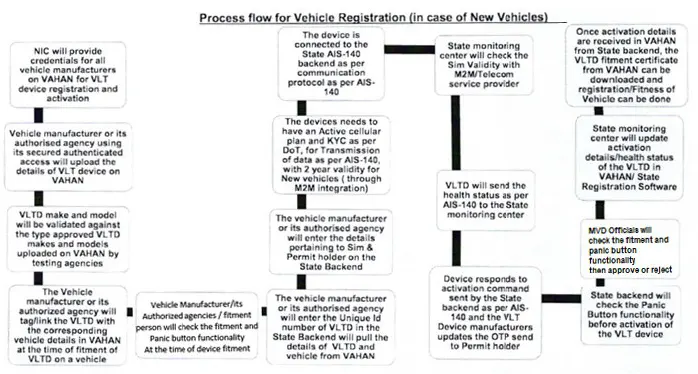
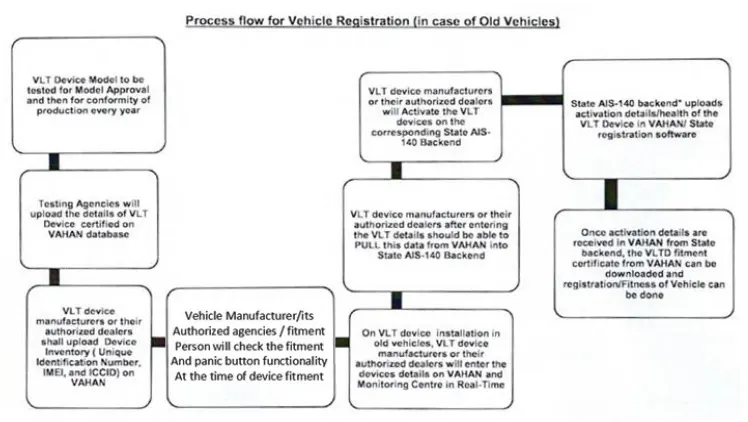
In case of retro-fitment in vehicles, the VLT device manufacturers or their authorized dealers shall install the VLT devices in public service vehicles and register the devices along with Unique Identification number and other details on VAHAN and the State Monitoring Centre in real-time.
The State/UT shall enforce fitment/functional status of device at the time of registration/ permit issuance/ renewal / fitness check of the vehicle in VAHAN or the respective state vehicle registration/ permit system and the State Monitoring Centre.
After the type approval, NIC shall provide credentials for the entire VLT Device manufacturer for uploading the Type approval data on VAHAN
VLT device manufacturers or their authorized dealers using its secured authenticated access will upload the following details of VLTD on VAHAN
- VLTD Make & Model
- Unique Identification Number of VLTD
- IMEI number
- ICCID number
VLTD make and model will be validated against the type approved VLTD makes and models uploaded on VAHAN by the test agencies.
The VLT device manufacturers or their authorized dealers will ensure that the VLTD has an active cellular plan with minimum two years validity for any public service vehicle less than 8 years old and one-year validity for any public service vehicle older than 8 years
The VLT device manufacturers or their authorized dealers shall install the VLT devices in public service vehicles and register the devices along with details of vehicle on the corresponding State Monitoring Centre in real-time.
The VLT device manufacturers or their authorized dealers will enter the following details of the VLTD on State monitoring centre-
- Model Code
- M2M Service Provider details
- SIM Details (Mobile Numbers, International Mobile Subscriber Identity (IMSI))
- Vehicle Details (Vehicle Type, Make, Model)
- Permit Holder Details (Name of Permit holder, number of Permit holder)
The State monitoring centre will establish connectivity with the VLTD and confirm that data is being received from the VLTD as per communication protocol as per AIS-140.
The State monitoring centre will check the SIM Validity (12 months) with M2M/Telecom service provider.
The VLTD will send the health status as per AIS-140 to the State monitoring centre.
The Device responds to activation command as per AIS-140 and the VLT device manufacturers or their authorized dealers updates the OTP send to Permit holder.
The State Monitoring Centre will check the Panic Button functionality as per AIS-140 before activation of the VLT device.
State monitoring centre will upload activation details/health status of the VLTD in VAHAN/ State Registration Software.
Once activation details are received in VAHAN from State AIS-140 backend/Common layer, the VLTD fitment certificate from VAHAN can be downloaded by the VLT device manufacturers or their authorized dealers and registration/ Fitness of Vehicle can be processed.
The specified public service vehicle owners have to ensure that the VLT devices installed in their vehicles, are in working condition and regularly send required data to the corresponding Monitoring Centre through cellular connectivity.
3. SOP for VLT Device Manufacturers
- VLT device registration & activation on VAHAN for new vehicles shall be carried out by vehicle manufacturers or their authorised agencies.
- NIC will provide credentials for all vehicle manufacturers on VAHAN for VLT device registration and activation. The VAHAN will have facility for the vehicle manufacturers to create their authorised agencies to carry out VLT device registration and activation on their behalf.
- The Vehicle manufacturer or its authorized agency using its secured authenticated access will upload the following details of VLT devices on VAHAN.
- VLTD Make & Model
- Unique Identification Number of VLTD
- IMEI number
- ICCID number
- At the time of tagging of VLTD on a vehicle, the Vehicle manufacturer or its authorized agency will tag/ link the VLTD with the corresponding vehicle details (Engine no. / Chassis Number) in VAHAN/ state registration application.
- Only those VLT Devices registered as per 3.2.3 will be allowed to be tagged against the vehicle type and model.
- The vehicle manufacturer will ensure that the VLTD has an active cellular plan with minimum two years validity at the time of registration of vehicle.
- The Vehicle manufacturer or its authorised agency will upload the details of VLTD on State monitoring centre as per the below step. The Vehicle manufacturer or its authorised agency will enter the Unique Identification number of VLTD and the State monitoring centre will pull the corresponding details of VLTD and vehicle from VAHAN.
- The Vehicle manufacturer or its authorised agency will enter the following details on State monitoring centre-o Model Code
- M2M Service Provider details
- Sim Details (Mobile Numbers, International Mobile Subscriber Identity(IMSI) o Vehicle Details (Vehicle Type, Make, Model)
- Permit Holder Details (Name of Permit holder, number of Permit holder)
4. SOP for Dealers/ RFC Centres
- Dealer will get the login credentials of State backend application from the corresponding VLTD manufacturers as per approval given by WBDT.
- First, link vehicle details with IMEI number in VAHAN.
- Dealers will check the fitment and panic button functionality at the time of device fitment with mobile App
- Dealer can login to the State backend application and tag the VLTD & vehicle.
- Enter the IMEI number & required details in the State backend application.
- Save the details by clicking the save button.
- Verify the owner mobile number through OTP and update the status of installation.
- Fitment of VLTD in the vehicle has to be inspected and approved by MVI.
- After Approval, download VAHAN certificate and Upload activation details to VAHAN.
Dealers should have the following facilities
- An office in the State with proper GST registration and GST number.
- Qualified & well trained technicians to fit the VLT device in vehicles.
- A minimum of one person with computer & internet knowledge for fitting and tagging device with State backend application.
- A minimum of one computer with internet connectivity & printer for printing the installation certificate.
- A customer support executive with an active telephone number. This number should be given to customer to call for support when required.
- Proper GST bill and agreed warranty assurance should be provided to vehicle owners.
- The dealer should confirm to the empanelment document of dated-16.07.2019/ Ref. No.CT-12-1-VTS(PMU)/2016-Vol-1079757.
5. Fitment of VLT device & Panic Buttons in Vehicle
- Position of VLTD fitment inside the vehicle
- Physical mounting of VLT device in vehicle should be as per AIS140 section 5.3. It is mentioned as ‘The VLT system shall be mounted in a suitable location such a way that it is not easily accessible/ exposed to passengers’.
- VLT device may be fitted over the dashboard for heavy vehicles and in a suitable location in light vehicles.
- Any kind of metal cover or shielding should be avoided over VLTD.
- The IMEI Number of VLT device should be clearly indicated above the device in such a way that it can be easily identified.
- Fitment of Panic Buttons inside the vehicles
- Emergency button(s) shall be fitted in such a way that every passenger including driver shall be able to access the Emergency button(s).
- Passenger Car shall have at least one emergency buttons on each passenger row easily accessible by each of the passenger.
- There shall also be one dedicated emergency button for the driver.
- Passenger Transport bus shall have emergency buttons at locations easily visible & accessible to all the passengers such as every 2 meters on both the sides on passenger seating area.
- For seats reserved for ladies there shall be a dedicated panic button for each row. It shall be permissible to have a single emergency button for two successive ladies’ rows on both sides of the vehicle provided each lady passenger in either row is able to reach and operate the emergency button.
- In case of passenger transport bus which has a glass window covered between two pillars having pitch 2 meter or more, the emergency buttons shall be provided on each pillar
- National Permit Trucks and other commercial vehicles shall have one dedicated emergency button for the driver. The panic button must be fitted near to driver seat and should be easily accessible to driver.
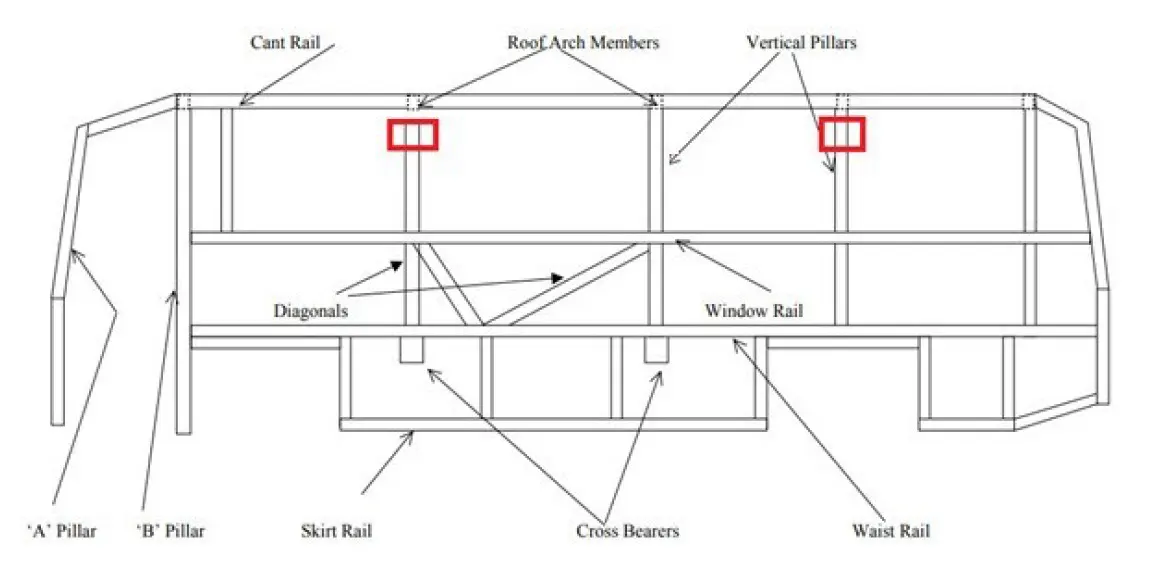
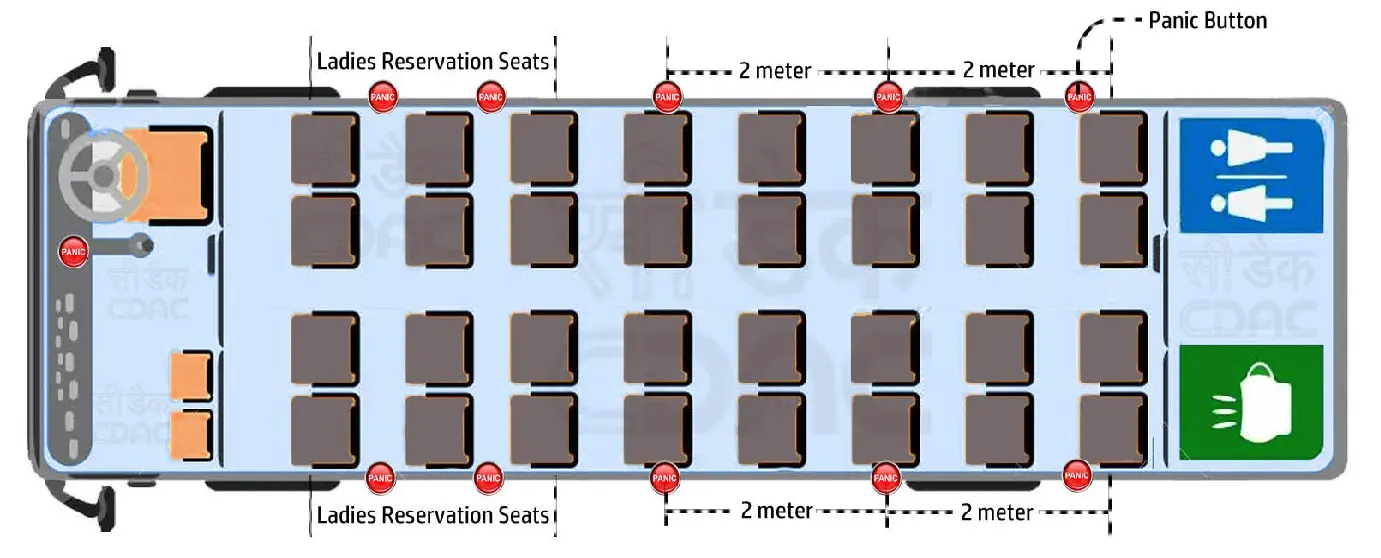
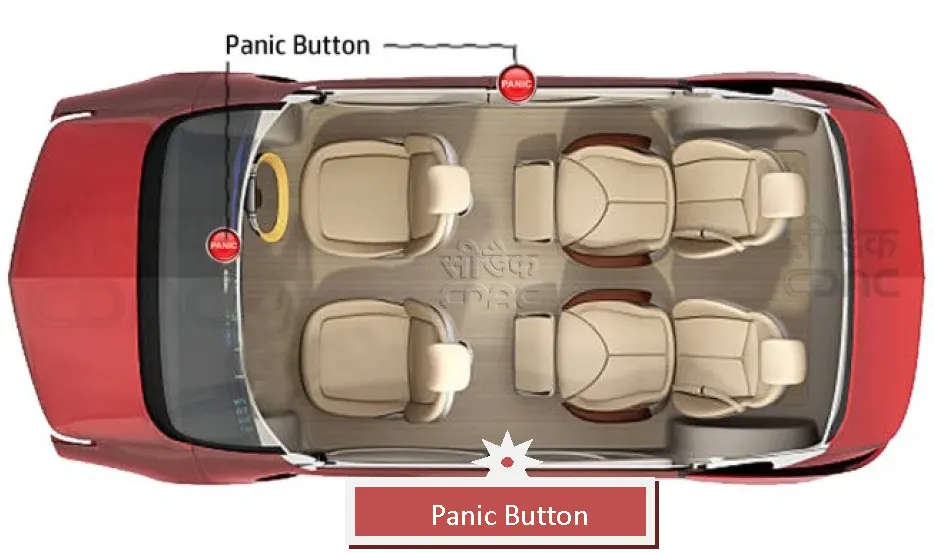
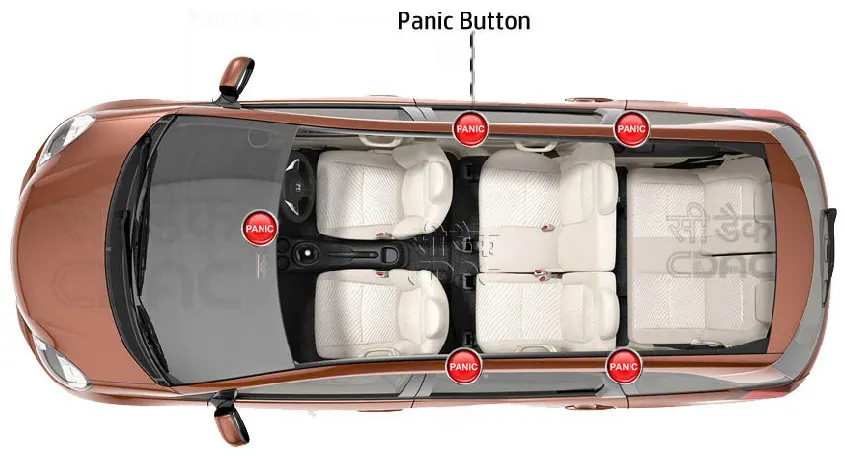
- Wiring of VLT and Panic buttons should confirm to AIS 140 Standard
- VLT devices and panic buttons should be properly wired in the vehicle.
- Wires to panic buttons and hooter/ buzzer should be provided with proper shielding or outer covering.
- No wires should be exposed or seen hanging.
- Wires should be properly coupled and should be fire proof.
- All safety precautions should be taken in fitment of VLT devices and panic buttons.
- Hooter/ buzzer(Optional)
- Hooter/buzzer for emergency condition and over speed alert should be loud enough to be audible to passengers and nearby people outside the vehicle.
- It should be placed in a convenient position inaccessible by passengers.
- Notice to Passengers & Public
- Proper indication to passengers and public should be given in the vehicle. Stickers indicating the fitment of Vehicle Tracking Device (Fitted with AIS140 Vehicle Tracking System & Panic Buttons) may be placed at front and back side of the vehicle.
- Information regarding the panic button should be provided to passengers. Messages indicating the use of Panic button should be placed inside the vehicle. eg: ‘Press in case of Emergency Only.
6. SOP for MVI/ AMVI
- After fitment of the VLTD and panic button in the vehicle, the vehicle has to be inspected by MVI/ AMVIs for the proper fitment of VLTD and panic buttons.
- The MVI/ AMVIs shall be given a mobile app through which they can check the fitment of VLTD and panic button.
- The major points to be verified by MVI/ AMVIs are (as per S.No.- 5 of this document)
- Physical fitment of VLTD and panic buttons
- Mounting of VLTD as per the guidelines
- Number of panic buttons
- Fitment of panic buttons as per the guidelines
- Wiring and connections
- LED indications of NC Type panic buttons
- Functional check of VLTD & panic buttons
- MVI/ AMVIs has to enter the vehicle number in the mobile app and verify the location of the vehicle shown in the app with the vehicle actual location
- Verify the data update time in the app
- Press panic buttons and check alert is received in the app. This emergency alerts generated before approval will not be forwarded to ERSS.
- Any alerts like over speed, Tilt etc. can be generated and verified by MVI/ AMVI if required.
- If fitment and functionality of the device is found satisfactory then MVI/ AMVI can approve the VLTD, If any issues are found then reject the VLTD.
- Physical fitment of VLTD and panic buttons
SOP for Vehicle Approval with Mobile Application for MVIs/AMVIs
- To approve, MVI/ AMVIs has to login using their registered mobile number and OTP send to the number.
- User can login to the application, on successful validation of entered details.
- Three options after login includes Old Vehicle, New Vehicle and Track Vehicle.
- Old vehicle option is to be selected for approving the vehicles that are tagged using registered vehicle number.
- New Vehicle option is to be selected for approving the vehicles that are tagged using chassis number.
- Approval can be done for the vehicles which are in Installed status only.
- Click the Locate button to locate the vehicle on the map.
- If vehicle cannot be located or the details displayed are incorrect, then click Reject button to reject.
- If vehicle can be located, then click Verify button to verify the details.
- After verifying the details, if any issue then click Reject button to reject.
- After successful verification, check ‘Field Verified’ check box and then click Approve button to approve the vehicle.
- Users can use Track Vehicle option to track the vehicle.
7. SOP for RTOs
- RTOs can approve the vehicle registration and CF in VAHAN.
8. SOP for Vehicle Owners
Fitment of Device
- Owner/ Customer has to approach the dealer of any of the approved VLTD Manufacturers as per the details available on WBDT’s website.
- Vehicle Owner is free to choose any approved VLTD Manufacturers and VLT device.
- Vehicle Owner may have to give the KYC details, RC book and mobile number to the dealer.
- Technician of the dealer will fit the device as per the process flow for vehicle registration defined above.
- After successful fitment and completion of data entry the owner will get his vehicle inspected by MVI/ AMVI to check the functionality of VLT Device as per AIS 140 Standard.
- MVI/ AMVI officials will inspect the vehicle to verify the fitment of device and panic buttons. If found satisfactory WBDT will approve it, else they may reject the device. In case of rejection owner has to approach the dealer to rectify or replace the device.
Operation of Device
- Once the device is approved the Monitoring & Control Centre (MCC) will continuously monitor your vehicle.
- The device generates various alerts and is monitored at the control room.
- The device should not be removed from the vehicle and should be continuously powered.
- The device and the panic buttons should be maintained in working condition without any failure.
- Tampered or non-functional device will deemed to be constitute as violation of permit condition and other prevailing Rules/ Acts.
- Most of the device has LED indications of its working status.
- If the device found to be faulty or the vehicle need some maintenance which require disconnection of the device, then it has to be immediately conveyed to the concerned dealer, dealer will register complaint in the application and Helpdesk of WB State’s Monitoring Control Centre for immediate rectification, logging the complain in to the WBDT’s Backend System for generating token for complain and compliance to the WBDT’s VLTD Manufactures registration documents for repair/replacements. This will avoid unnecessary alerts like Panic wire cut, Tilt, Main power removal etc.
Operation of Panic Buttons
- Panic buttons are important part of AIS140 implementation. These buttons are placed for the safety of passengers and drivers.
- In case of any emergency, the passenger or driver can press the panic button to inform the control room about the emergency situation.
- All panic buttons have a continuous glowing LED to indicate that the button is working. On pressing of the button the LED will start blinking and the hooter (optional) will start making sound. The device will also send SMS about the emergency condition to control room as well as owner.
- If any repair or maintenance is required for which panic button needs to be removed, then immediately inform dealer and ask them to register a complaint entry.
Subscription renewal
- Vehicle owner should renew the subscription of the device every year before the test for certificate of fitness.
- The vehicle owner should get a renewal certificate from the manufacturer stating that the subscription has been renewed.
The State monitoring center will ensure that VLTD connected and sending data as per communication protocol AIS-140.
The State monitoring center will check the Sim Validity (24 months) with M2M/ Telecom service provider.
The State Monitoring Center will ensure that VLTD is sending the health status as per AIS-140 to the State Monitoring Center.
The State Monitoring Center will ensure that Device responds to activation command sent by the State backend as per AIS-140 and the VLT device manufacturer/OEM dealer/Authorised dealer updates the OTP send to permit holder.
The State Monitoring Center will check the Panic Button functionality as per AIS-140 before activation of the VLT device
State Monitoring Center will update activation details/health status of the VLTD in VAHAN/ State Registration Software.
Once activation details are received in VAHAN from State AIS-140 backend/Common layer, the VLTD fitment certificate from VAHAN can be downloaded and registration/Fitness of Vehicle can be processed.
The specified public service vehicle owners have to ensure that the VLT devices installed in their vehicles, are in working condition and regularly send required data to the corresponding state Monitoring Center through cellular connectivity.
General Guidelines for Implementation of State-wise Monitoring Center for VLT devices as per AIS-140
The specified public service vehicle owners have to ensure that the VLT devices installed in their vehicles are in working condition and regularly send required data to the corresponding Monitoring Center through cellular connectivity.
The specified new public service vehicles shall not be registered in the State/UT, if the vehicles are not equipped with or fitted with vehicle location tracking device and one or more emergency buttons, in compliance with the CMVR 1989. The Unique Identification number and others details of each VLT device shall be uploaded on the VAHAN by the Vehicle manufacturer or its authorized agency, in case of New Vehicles using their secured authenticated access The Unique Identification number of VLTD shall be tagged to vehicles details (Engine no. / Chassis Number) in VAHAN for the purpose of linking the VLT device to the specific public service vehicle. For the registration of new PSV in VAHAN, the VLTD shall be activated and functional and the Unique ID of VLTD shall be tagged to the vehicles in VAHAN.
In case of retro-fitment in vehicles, the VLT device manufacturer/OEM dealer/Authorised dealer shall install the VLT devices in public service vehicles and register the devices along with Unique Identification number and other details on VAHAN and the corresponding Monitoring Center systems in real-time.
The State/UT shall enforce fitment/functional status of device at the time of registration/ permit issuance/ renewal / fitness check of the vehicle in VAHAN or the respective state vehicle registration/ permit system and the State/UT Monitoring System.
The VLT device shall be activated on the Monitoring Center as per the process set-out in AIS 140 and the functional status shall be updated in VAHAN / State Registration Backend of the State.
The State/UTs shall ensure compliance to rule 125 H of Central Motor Vehicles Rules, 1989 and check fitment and functional status of the VLT device in the public service vehicles at the time of checking of the vehicles for fitness certification in VAHAN and State/UT Monitoring Center.
The State/UTs shall ensure compliance to rule 125 H of Central Motor Vehicles Rules, 1989 and check fitment and functional status of the VLT device in the public service vehicles at the time of checking of the vehicles for fitness certification in VAHAN and State/UT Monitoring Center.
The States/UTs shall ensure a strict compliance of SOP for implementation of Vehicle Tracking Platform as per AIS 140 Specification
Checklist for VLTD Fitment Approval
Vehicle Registration No:
VLTD IMEI No:
Inspection date:
| Sl No. | Items to Verify | Status (Yes/ No) | Remarks |
| 1. | Mounting of VLTD | ||
| 2. | Number of Panic Buttons | ||
| 3. | Fitment of Panic Buttons | ||
| 4. | Wiring and connections | ||
| 5. | Location Verification in mobile app | ||
| 6. | Data Update Time in mobile app | ||
| 7. | Panic Alert Check | ||
| 8. | Other alerts (Optional) | ||
| 9. | Messages/ Stickers about panic buttons inside vehicle (Optional) |
Inspected By
Name:
Status:
Approved/ Reject
Designation:
Signature:
Office Seal
No. 466-T dated 08.12.2022, Source
🕒 02.01.2023 🏷️ VLT